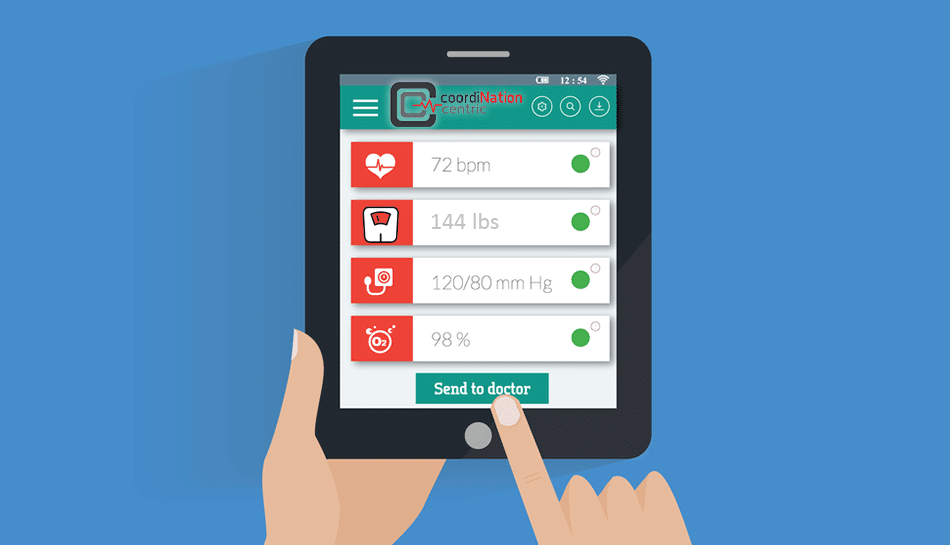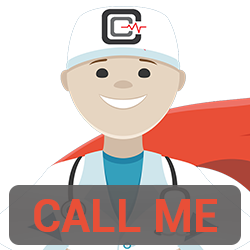
“Greater access to proven remote patient monitoring technologies can lead to safer, more effective monitoring of health and safety among older adults.”
Public Health Institute
The Upward Trend of Using Remote Patient Monitoring

Source: Berg Insight
Remote patient monitoring uses devices to perform routine tests (like checking glucose levels for patients with diabetes or checking blood pressure for patients receiving cardiac care) and sends the data to the doctor’s office in real time, over the Internet, using existing cellular technology.
The doctor’s team can then assess the information and adjust the patient’s treatment plan in a much more proactive manner.
The telehealth technology is no longer a convenience; rather, due to the aging population causing a strain on healthcare systems and rising healthcare costs, utilizing this technology is becoming a requirement.
In 2016, 7.1 million patients were remotely monitored. This number represented an increase of 44% from the previous year. By 2021, it is projected that 50.2 million people worldwide will be remotely monitored. This phenomenon is due to 2 factors:
- rising acceptance in several key medical verticals
- cellular technology becoming the de-facto standard communication device for medical monitoring devices
There is no denying that as technology changes and improves, patient care progresses. In this article, we’ll detail how doctors are using this technology to improve patient care, why telehealth is becoming so popular with physicians & patients, why resistance still occurs, reimbursement from CMS, and what doctors need to do to get started.
What Symptoms Are Doctors Using Remote Patient Monitoring For?
Imagine being able to track blood sugar levels from chronically ill patients suffering from diabetes. Would this daily inflow of information help you see trends, adjust medication as needed, and prevent readmission?
Not only can remote patient monitoring help drive down hospital readmission rates, resulting in more cost-effective treatment, but it can also reduce the initial hospital visits for patients with chronic illnesses, like high blood pressure, diabetes, heart disease, and even obesity!
For instance, if RPM technologies transmit patient vitals and symptoms to medical offices, it could serve to alert health care professionals of impending issues before the patient ever has to resort to hospital or emergency room services.
Why Is Telehealth So Popular With Patients?
 In addition to the doctor’s care team being able to provide better treatment, patients are highly satisfied with utilizing telemonitoring to save time and travel. No matter how nice your clinic may be, no one wants to go there if they can avoid doing so. Traveling for the chronically ill, even if it’s just a few miles, can be a time-consuming inconvenience.
In addition to the doctor’s care team being able to provide better treatment, patients are highly satisfied with utilizing telemonitoring to save time and travel. No matter how nice your clinic may be, no one wants to go there if they can avoid doing so. Traveling for the chronically ill, even if it’s just a few miles, can be a time-consuming inconvenience.
Also, patients like the information they receive by tracking every day. This daily feedback combined with the accountability of sharing this information with others helps them participate more actively in their care.
Finally, it saves them money as reduced clinic visits equal reduced payments for patients, and proactive monitoring results to fewer emergency room visits.
Will Medicare Pay For This Service?
Medicare used to lump all telehealth services under 1 CPT Code 99091. However, in November of 2018, Medicare created new CPT codes to financially incentive doctors to utilize this service. The new Chronic Care Remote Physiologic Monitoring codes are:
- CPT code 99453: Initial setup. Pays approximately $21. “Remote monitoring of physiologic parameter(s) (eg, weight, blood pressure, pulse oximetry, respiratory flow rate), initial; set-up and patient education on use of equipment.”
- CPT code 99454: Device/transmission fee. Pays approximately $69 per month. “Remote monitoring of physiologic parameter(s) (eg, weight, blood pressure, pulse oximetry, respiratory flow rate), initial; device(s) supply with daily recording(s) or programmed alert(s) transmission, each 30 days.”
- CPT code 99457: Monitoring and treatment. Pays approximately $53 per month for 20 minutes of time spent viewing data and communicating with patients. “Remote physiologic monitoring treatment management services, 20 minutes or more of clinical staff/physician/other qualified healthcare professional time in a calendar month requiring interactive communication with the patient/caregiver during the month.”
The 3 main differences with the new payment rules are the ability of the physician to bill for the initial set up & patient education, the fact that the clinical staff can perform these services, and the requirement of only 20 minutes per calendar month (vs 20 minutes in 30-day span).
Factors That Cause Physicians To Resist
While greater numbers of physicians and patients are receptive to using remote patient monitoring, there is still some hesitation. Typically, this resistance falls into 3 categories:
- Still a relatively new concept
- Patient compliance difficulties
- Reliability of data
When a doctor’s office is ready to start using remote patient monitoring services, it will want to look for a company that helps with training, has state of the art equipment & technologies, and can assist in communicating with patients for compliance purposes.
Why Use Remote Patient Monitoring
In the video below, Ives Soto, the Director of Provider Relations for Coordination Centric, explains the benefits of Remote Patient Monitoring for Physicians:
How To Get Started Using Remote Patient Monitoring
 Coordination Centric offers both the Telemonitoring Equipment and the Software. The Telemonitoring Equipment (Blood Pressure, Blood Glucose, Pulse Oximetry, Scale Devices) goes in the Patient’s Home and communicates (via the cellular signal) near real-time to the Doctor with up-to-date patient vital information.
Coordination Centric offers both the Telemonitoring Equipment and the Software. The Telemonitoring Equipment (Blood Pressure, Blood Glucose, Pulse Oximetry, Scale Devices) goes in the Patient’s Home and communicates (via the cellular signal) near real-time to the Doctor with up-to-date patient vital information.
“The Bridge“ Telemonitoring Software is our State of the Art Clinical Call Center Software for the management of large scale telemonitoring operations.
In addition to The Bridge Software, Coordination Centric also offers Connectivity Management, Customer Support, Training, Newsletters and Monthly Q/A.
If you’re interested in learning more, contact us and we’re happy to visit your office and go over how our program works (in just about 20 minutes).
Summary of Why More Physicians Are Using Remote Patient Monitoring To Better Serve Their Patients
Again, RPM is the next big thing in patient care, projected to keep growing, and your patients love the benefits, convenience, and overall improved health. Some other reasons why physicians will benefit from remote patient monitoring include the ease in which they can access patient data, ability to deliver higher-quality care, fewer readmissions, fewer revisits, less opportunities for burnout, the ability to assign to clinical staff, higher reimbursements thru Medicare and lower overall costs.
Any questions about telehealth and remote patient monitoring services? Leave them below!


1 Comment
What Are The Benefits Of Remote Patient Monitoring? - Coordination Centric
-March 15, 2019 - 2:29 pm[…] in developing countries is projected to almost triple to 1.5 billion by 2050. With such growth, remote patient monitoring services will become a requirement for managing chronic medical […]
Comments are closed.